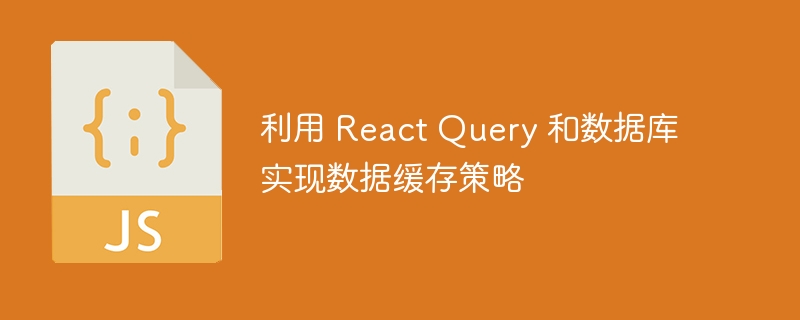Home >Web Front-end >JS Tutorial >Implement data caching strategy using React Query and database
Implement data caching strategy using React Query and database
- WBOYWBOYWBOYWBOYWBOYWBOYWBOYWBOYWBOYWBOYWBOYWBOYWBOriginal
- 2023-09-26 17:54:32776browse

Using React Query and database to implement data caching strategy
Introduction:
In modern web applications, data is very important. In order to improve application performance and user experience, we need to use appropriate strategies for data caching. React Query is an excellent data management and state management library that provides powerful functions to help us cache and update data in real time. This article will introduce how to use React Query and a database to implement a data caching strategy, and provide specific code examples.
1. Introduction to React Query
React Query is a data management library designed specifically for React applications. Its goal is to provide a simple and powerful way to manage data in applications. React Query provides a series of Hooks and APIs to handle operations such as data acquisition, caching, updating and invalidation. It also supports custom queries, optimistic updates, real-time updates and other functions, making it ideal for building complex front-end applications.
2. Basic principles of data caching
When designing a data caching strategy, we need to consider the following basic principles:
- When obtaining data, first search it from the cache , if there is data in the cache, it will be returned directly. If there is no data in the cache, get it from the server and update the cache.
- When data is updated, the data on the server is updated first, and then the data in the cache is updated. This ensures data consistency.
- For different data, different cache times can be set. Some frequently updated data can be set to a shorter cache time, and some infrequently updated data can be set to a longer cache time.
3. Use React Query and database to implement data caching
-
Install React Query
First, we need to install the React Query library. You can use npm or yarn to install:npm install react-query
-
Configuring React Query Provider
In the entry file of the application, we need to configure the Provider component of React Query:import React from 'react'; import { QueryClient, QueryClientProvider } from 'react-query'; const queryClient = new QueryClient(); function App() { return ( <QueryClientProvider client={queryClient}> {/* 应用程序的根组件 */} </QueryClientProvider> ); } export default App; -
Create API
Next, we need to create an API to interact with the database. You can use libraries such as fetch and axios to make HTTP requests:import axios from 'axios'; export const fetchTodos = async () => { const response = await axios.get('/api/todos'); return response.data; }; export const createTodo = async (todo) => { const response = await axios.post('/api/todos', { todo }); return response.data; }; // 其他API函数... -
Create Query Hooks
In React Query, we can use Hooks such as useQuery and useMutation to define and manage data queries and Modification:import { useQuery, useMutation } from 'react-query'; import { fetchTodos, createTodo } from './api'; export function useTodos() { return useQuery('todos', fetchTodos); } export function useCreateTodo() { const queryClient = useQueryClient(); return useMutation(createTodo, { onSuccess: () => { queryClient.invalidateQueries('todos'); }, }); } // 其他Query Hooks... -
Using Query Hooks in components
In our components, we can use the Query Hooks just created to obtain and modify data:import React from 'react'; import { useTodos, useCreateTodo } from './hooks'; function TodoList() { const { data, isLoading, isError } = useTodos(); const { mutate } = useCreateTodo(); if (isLoading) { return <div>Loading...</div>; } if (isError) { return <div>Error</div>; } return ( <div> {data.map(todo => ( <div key={todo.id}>{todo.title}</div> ))} <button onClick={() => mutate({ title: 'New Todo' })}> Add Todo </button> </div> ); }
4. Summary
By using React Query and the database, we can easily implement the data caching strategy. React Query provides rich features and APIs that allow us to process data in a more elegant and efficient way. In actual applications, we can configure cache time and update strategies according to specific needs, thereby improving application performance and user experience.
The above is the basic introduction and code examples of using React Query and database to implement data caching strategies. I hope it will be helpful for you to understand and apply React Query. Good luck writing better React applications!
The above is the detailed content of Implement data caching strategy using React Query and database. For more information, please follow other related articles on the PHP Chinese website!

